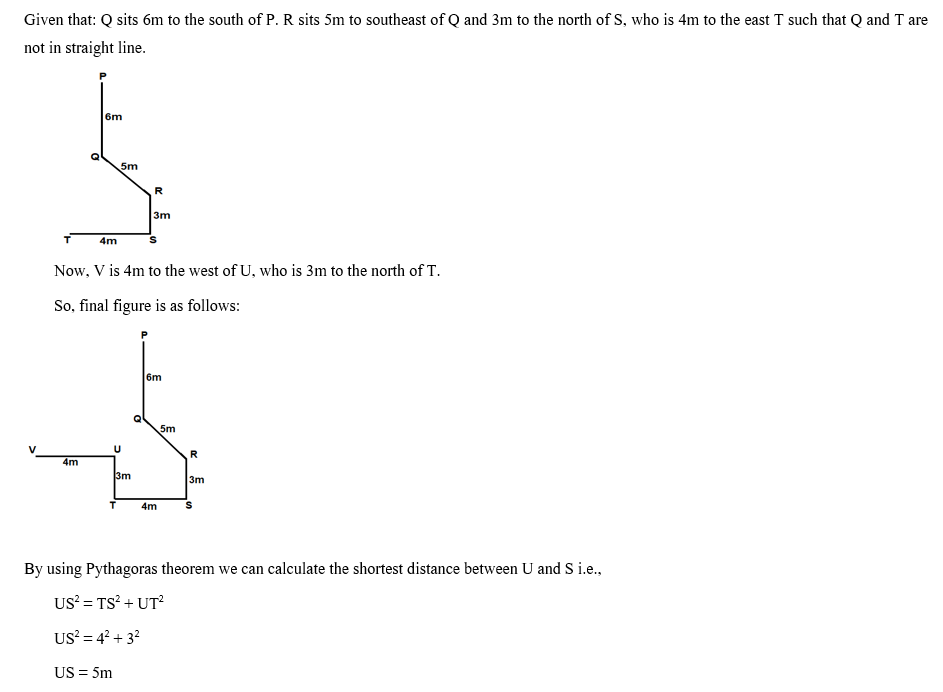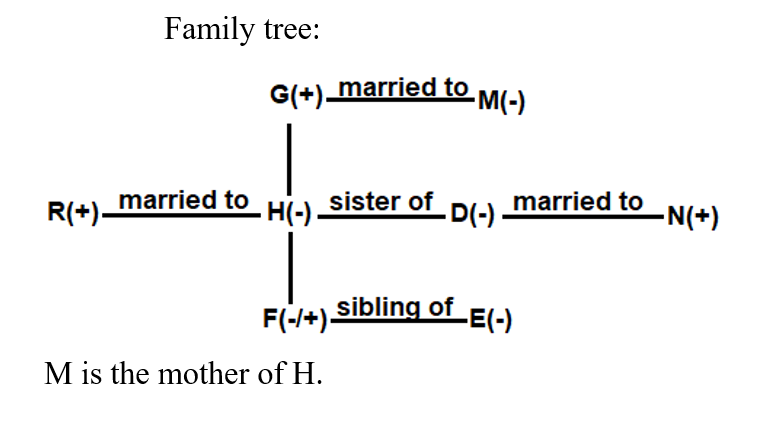Question 1:
Direction: In the question, assuming the given statements to be true, find which of the conclusion (s) among given three conclusions is /are definitely true and then give your answer accordingly.
निर्देश: निम्नलिखित प्रश्न में, दिए गए कथनों को सत्य मानकर, यह तय करना है कि दिए गए तीन निष्कर्षों में से कौन सा निष्कर्ष निश्चित रूप से सत्य है और फिर उसी अनुसार अपना उत्तर दें।
Statements: / कथन
9 ≥ S<D<7; K ≤ S<2; K>C>A
Conclusions: / निष्कर्ष
I. A<D
II. 9>2
III. 2 ≥ C
Question 2:
Direction: In the question, assuming the given statements to be true, find which of the conclusion (s) among given three conclusions is /are definitely true and then give your answer accordingly.
निर्देश: निम्नलिखित प्रश्न में, दिए गए कथनों को सत्य मानकर, यह तय करना है कि दिए गए तीन निष्कर्षों में से कौन सा निष्कर्ष निश्चित रूप से सत्य है और फिर उसी अनुसार अपना उत्तर दें।
Statements: / कथन
C ≥ D>G = J; L ≤ J>K ≥ W>A
Conclusions: / निष्कर्षः
I. D>A
II. L<A
III. C>L
Question 3:
Which of the following should be placed in the blank spaces respectively (in the same order from left to right) in order to complete the given expression in such a manner that doesn’t make the expression ‘P > V’ definitely true?
निर्देश: निम्नलिखित प्रश्न में, दिए गए कथनों को सत्य मानकर, यह तय करना है कि दिए गए तीन निष्कर्षों में से कौन सा निष्कर्ष निश्चित रूप से सत्य है और फिर उसी अनुसार अपना उत्तर दें।
__ ≤ __ < __ > __< __
Question 4:
If in the word, FAVOURABLE, 4th, 7th and 9th letters are replaced by their 2nd succeeding letter as per Alphabetical series, then, then how many meaningful English words can be formed from 4th, 7th and 9th letters after the replacement?
यदि शब्द FAVOURABLE में चौथे, सातवें और नौवें अक्षर को वर्णमाला श्रृंखला के अनुसार उनके दुसरे अगले अक्षर से प्रतिस्थापित किया जाता है तो प्रतिस्थापन के बाद चौथे, सातवें और नौवें अक्षर से कितने सार्थक अंग्रेजी शब्द का निर्माण किया जा सकता है?
Question 5:
25. How many such numerals are there in the number ‘238953872’ which will remain at the same position when arranged in ascending order from the right to left? 25.
यदि संख्या '238953872' में अंको को दाएँ से बाएं आरोही क्रम में व्यवस्थित किया जाता है तो कितने अंकों के स्थान में कोई बदलाव नहीं होता है?
Question 6: 
Question 7: 
Question 8:
Directions: Answer the questions based on the information given below.
निर्देश: दिए गए जानकारी के आधार पर सवालों के उत्तर दें।
There are eight members in the family having three generations. Three couples are there in the family. No single person is a parent in the family.
G is the father H, who is the mother of F. E is the granddaughter of M, who is the mother-in-law of N. R is the brother-in-law of D, who is the sister of H. F is sibling of E, who is daughter of H.
तीन पीढ़ी के एक परिवार में आठ सदस्य हैं। परिवार में तीन युगल हैं। परिवार में कोई एकल अभिवावक नहीं है।
GH का पिता है और HF की माता है। EM की पोती/नवासी है और MN की सास है। RD का साला/जीजा/देवर है और DH की बहन है। FE का भाई बहन है और E H की पुत्री है।
How is M related to H?
M H से कैसे सम्बंधित है?
Question 9:
Directions: Answer the questions based on the information given below.
निर्देश: दिए गए जानकारी के आधार पर सवालों के उत्तर दें।
There are eight members in the family having three generations. Three couples are there in the family. No single person is a parent in the family.
G is the father H, who is the mother of F. E is the granddaughter of M, who is the mother-in-law of N. R is the brother-in-law of D, who is the sister of H. F is sibling of E, who is daughter of H.
तीन पीढ़ी के एक परिवार में आठ सदस्य हैं। परिवार में तीन युगल हैं। परिवार में कोई एकल अभिवावक नहीं है।
GH का पिता है और HF की माता है। EM की पोती/नवासी है और MN की सास है। RD का साला/जीजा/देवर है और DH की बहन है। FE का भाई बहन है और E H की पुत्री है।
If H has only one daughter, then how is F related to father-in-law of N?
यदि H की केवल एक पुत्री है, तो F N के ससुर से कैसे सम्बंधित है?
Question 10:
Directions: Answer the questions based on the information given below.
निर्देश: दिए गए जानकारी के आधार पर सवालों के उत्तर दें।
There are eight members in the family having three generations. Three couples are there in the family. No single person is a parent in the family.
G is the father H, who is the mother of F. E is the granddaughter of M, who is the mother-in-law of N. R is the brother-in-law of D, who is the sister of H. F is sibling of E, who is daughter of H.
तीन पीढ़ी के एक परिवार में आठ सदस्य हैं। परिवार में तीन युगल हैं। परिवार में कोई एकल अभिवावक नहीं है।
GH का पिता है और HF की माता है। EM की पोती/नवासी है और MN की सास है। RD का साला/जीजा/देवर है और DH की बहन है। FE का भाई बहन है और E H की पुत्री है।
How is D related to E?
D E से कैसे सम्बंधित है?





